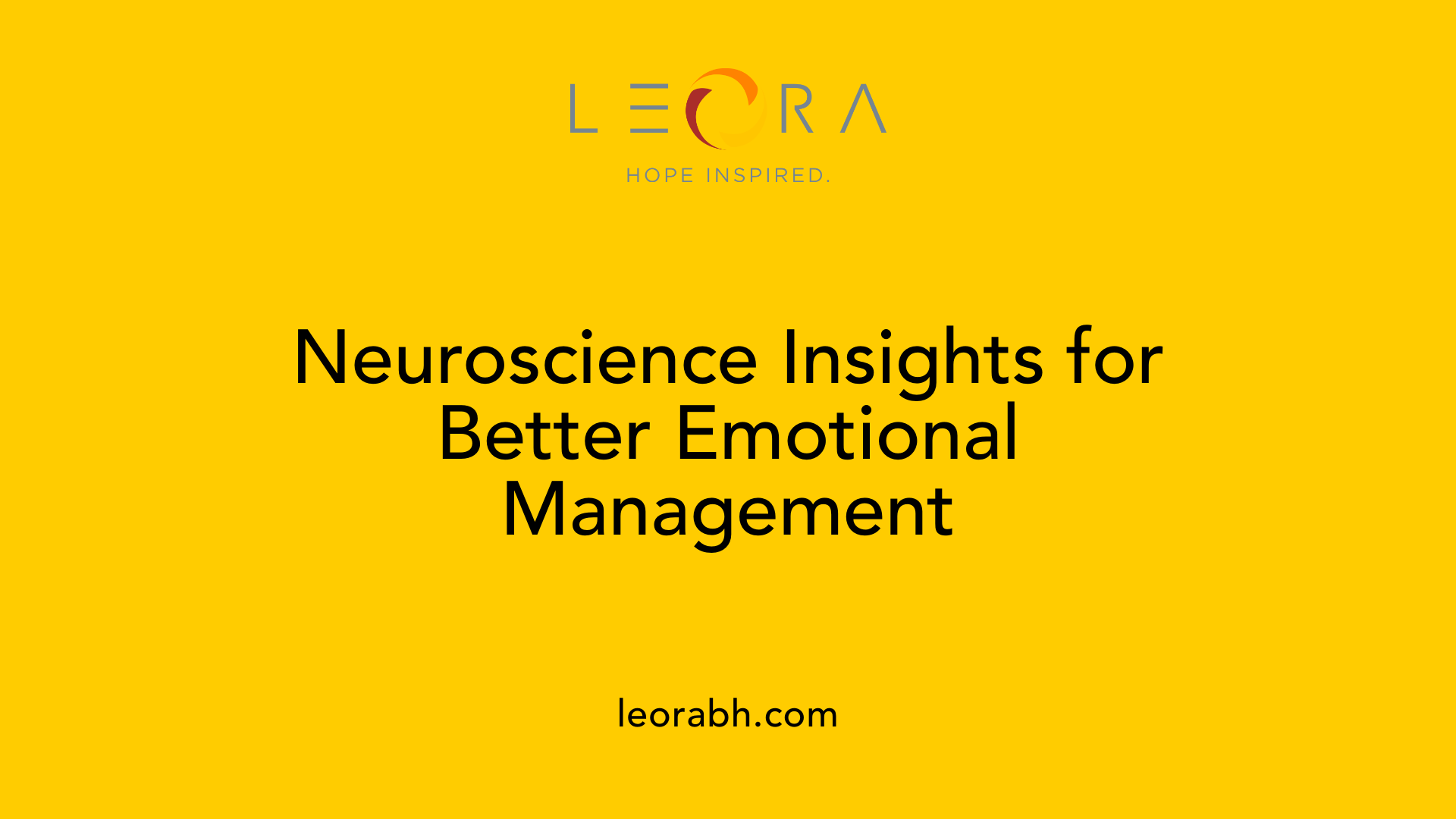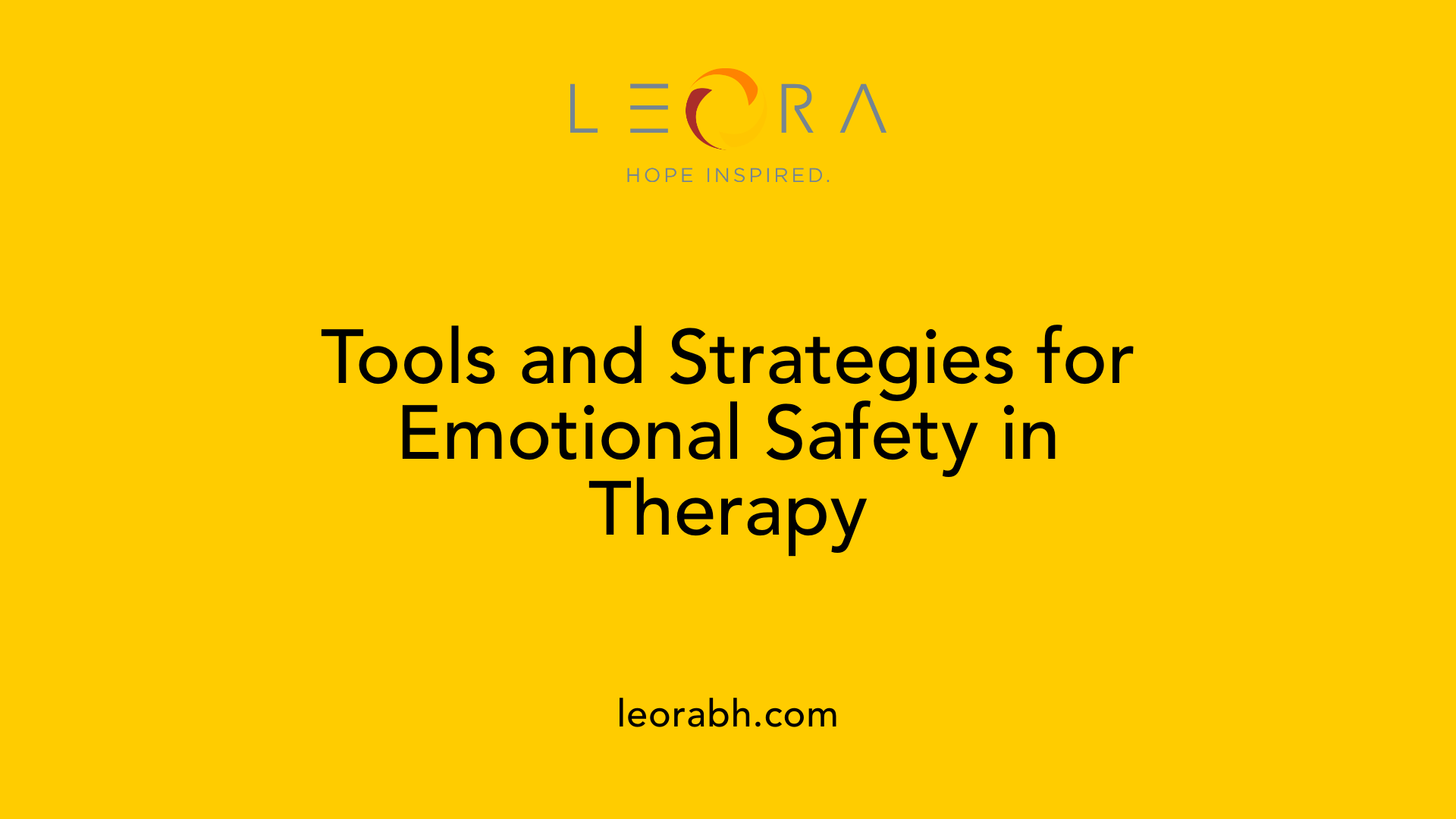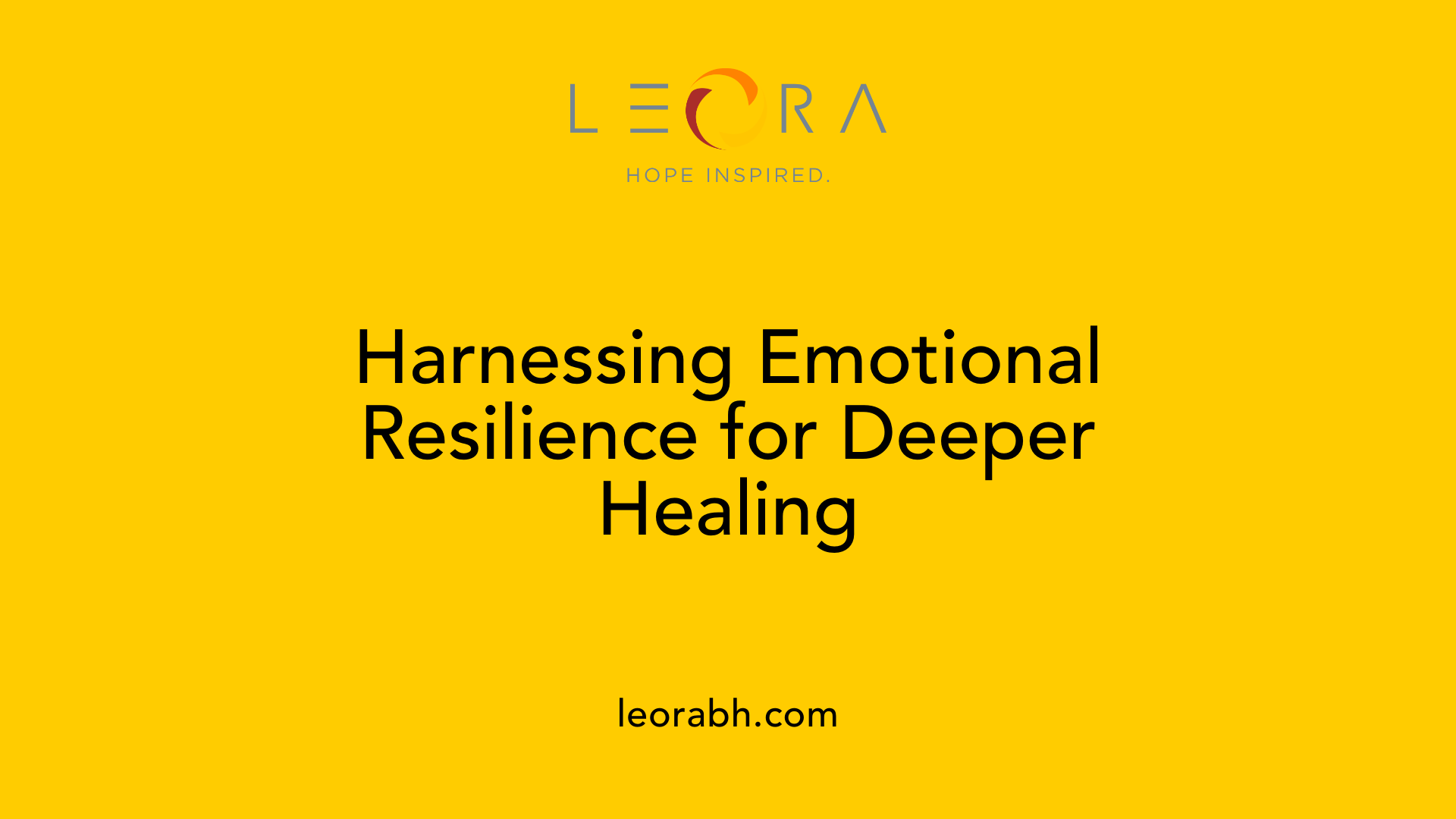Tips for managing emotions during therapy breakthroughs
Mastering Emotional Balance to Enhance Therapeutic Progress
Understanding Emotional Regulation in Therapy
Navigating emotional responses during therapy breakthroughs can be challenging, but mastering self-regulation is key to maximizing therapeutic benefits. This article explores practical strategies, scientific insights, and supportive techniques to help both clients and therapists manage intense emotions effectively, fostering growth and healing.
Understanding the Foundations of Emotional Regulation

What is emotional regulation and why is it important?
Emotional regulation refers to the ability to manage and respond to emotional experiences in a way that maintains emotional balance and promotes well-being. This skill is vital because it influences how individuals handle stress, cope with challenges, and sustain healthy relationships. Effective emotional regulation helps prevent impulsive reactions, reduces stress levels, and supports mental health. Conversely, difficulties in regulating emotions can lead to issues such as mood swings, impulsivity, and strained relationships, adversely affecting overall life satisfaction and physical health.
What influences emotional regulation?
Numerous factors shape how we regulate emotions. Genetics play a role by determining predispositions to certain emotional responses. Our environment, including childhood experiences and social context, also significantly impacts emotional skills. Mental health conditions, such as anxiety or emotional dysregulation disorders, can make managing emotions more challenging. Developmentally, emotional regulation evolves over time, with early childhood experiences establishing the foundation for adult skills.
How do conscious and unconscious processes contribute?
Both conscious and unconscious processes are involved in emotional regulation. Conscious strategies include mindfulness, cognitive reappraisal, and therapy techniques that actively modify emotional responses. Unconscious processes, such as automatic reactions based on ingrained patterns or neural pathways, also influence how emotions are experienced and expressed. Neuroscientifically, regions like the amygdala (processing emotional reactions) and the prefrontal cortex (regulating impulses) work together to manage emotional responses. Top-down control from the prefrontal cortex helps individuals respond appropriately to emotional stimuli, whether by calming reactive responses or amplifying positive emotions.
Strategies to improve emotional awareness and regulation
Several evidence-based approaches support emotional regulation. Mindfulness practices cultivate present-moment awareness, helping individuals observe their emotions without judgment. Cognitive reappraisal involves reframing negative thoughts to change emotional reactions. Acceptance and Commitment Therapy (ACT) encourages embracing emotions while committing to valued actions. Dialectical Behavior Therapy (DBT), widely used for emotional dysregulation, emphasizes skills in distress tolerance, emotional regulation, and interpersonal effectiveness.
Activities such as breathing exercises, physical movement, and self-awareness practices can also enhance emotional control. These strategies teach individuals how to pause during emotional surges, acknowledge their feelings, and choose appropriate, adaptive responses.
Core components of emotional regulation and self-care in therapy
Developing emotional self-regulation involves several core components. First, emotional literacy allows individuals to identify, understand, and label feelings accurately. Mindfulness and relaxation techniques, such as deep breathing or meditation, help lower physiological arousal and foster calmness.
Self-compassion is crucial for responding kindly to oneself during challenging emotional episodes. Setting healthy boundaries and seeking social support are also vital strategies for maintaining emotional stability. Engaging in resilience-building activities like hobbies, journaling, or reflective practices provides a sense of control and stability.
By integrating these elements, individuals can create a personalized toolkit that promotes sustained emotional health. Therapy further supports this process by helping clients recognize triggers, refine coping skills, and develop psychological flexibility.
Theories explaining emotion regulation
Understanding different theoretical perspectives enhances our grasp of emotion regulation mechanisms. The dual-process theory highlights the interaction between automatic, unconscious responses and conscious, deliberate control. Polyvagal theory emphasizes the role of autonomic nervous system states, such as safe, fight/flight, or shutdown, in emotional responses and regulation.
Gross’s process model categorizes regulation strategies into antecedent-focused (before emotion fully develops) and response-focused (after emotion arises) techniques, illustrating how regulation can occur at various stages.
The cognitive-behavioral model focuses on changing maladaptive thoughts and behaviors that sustain emotional distress, supporting the use of cognitive restructuring and behavioral activation.
The neurophysiology of emotion regulation
From a neuroscientific perspective, emotion regulation involves complex brain networks, primarily the amygdala and prefrontal cortex. The amygdala detects threats and triggers emotional responses, while the prefrontal cortex modulates these responses through top-down control.
Effective regulation depends on the strength of connections between these regions. When the prefrontal cortex exerts influence over the amygdala, individuals can better calm their emotional reactions. Disruptions in this neural circuitry can impair regulation, leading to heightened reactivity or emotional dysregulation.
Factors influencing emotion regulation
Several factors affect emotional regulation capacity. Genetics determine predispositions but can be influenced by experiences. Physiological state, such as fatigue or illness, impacts emotional responses. Childhood development and early life experiences shape baseline emotional skills.
Environmental stressors, including trauma, social support, and cultural norms, influence how emotions are expressed and managed. Mental health conditions like anxiety, depression, or emotional regulation disorder can hinder effective regulation.
Gender differences in emotion regulation
Research indicates that gender socialization and cultural expectations influence emotion regulation strategies. Women are generally more expressive and tend to utilize emotion-focused strategies like seeking social support. Men often adopt suppressive tactics, such as emotional inhibition, partly due to societal norms about masculinity.
Neural pathways also show sex differences, with some studies suggesting variations in brain activity related to emotion processing and regulation. Despite these general trends, individual differences are considerable, and ongoing research continues to explore these disparities.
Practical methods and therapies for developing emotional regulation
Practicing specific skills enhances emotional regulation. Techniques like the Stop-Breathe-Reflect-Choose method encourage pausing, calming, and thoughtfully responding to emotional stimuli.
Mindfulness-based therapies, including Mindfulness-Based Cognitive Therapy (MBCT) and Acceptance and Commitment Therapy (ACT), teach acceptance of emotions and present-moment awareness. Dialectical Behavior Therapy (DBT) offers skills in distress tolerance, emotional regulation, and interpersonal effectiveness.
Activities such as physical exercise, breathing exercises, and movement therapies (e.g., dance/movement therapy) engage body-mind connection to promote emotional balance.
Recognizing and celebrating emotional breakthroughs
During therapy, moments of insight or shifts in perspective—called breakthroughs—are significant markers of progress. These can include realizations that certain emotions are normal, recognizing the validity of vulnerable feelings, or understanding underlying causes of emotional reactions.
Experiencing crying or emotional release during therapy can be a sign of vulnerability and healing, although it’s not obligatory for progress. Tears can signify the processing of deep wounds and the acceptance of complex feelings.
Signs of a psychotherapy breakthrough include increased self-acceptance, improved relationship skills, and reduction in harmful behaviors. These moments often foster growth, healing, and greater emotional resilience.
The role of body language and movement in emotion regulation
Body language, facial expressions, and movement play integral roles in the regulation and expression of emotions. Movements associated with certain feelings can either amplify or diminish those emotions. Therapies like dance/movement therapy leverage this connection, encouraging clients to explore various motor patterns to experience and modify emotional states.
Mirror neurons activate when observing movement, fostering empathy and understanding. Therapists can utilize movement mirroring and mimicry to build rapport and facilitate emotional sharing.
Both qualitative (posture, facial expression) and quantitative (physical activity) motor behaviors influence mood via physiological pathways. Regular movement activities can elevate mood, reduce stress, and improve sleep, contributing to overall emotional stability.
Strategies for ongoing emotional regulation
Sustained emotional regulation skills involve intentional strategies, such as:
- Identifying and reducing triggers
- Using physical and psychological grounding techniques
- Considering alternative explanations for emotional reactions
- Responding thoughtfully instead of impulsively
- Maintaining social connections and seeking support
- Regularly practicing mindfulness and self-care activities
Developing these habits over time helps mitigate the impact of overwhelming emotions and promotes a balanced mental state.
Summing up: Skills and tools for emotional management
Mastering emotional regulation is a lifelong journey. It requires awareness, practice, and often professional support. Therapies like DBT, CBT, and mindfulness-based approaches offer practical skills to enhance emotional control.
Creating a personalized toolkit—comprising breathing exercises, journaling, movement, positive self-talk, and seeking social support—empowers individuals to face emotional challenges effectively. Recognizing early warning signs, understanding personal triggers, and implementing proactive strategies can lead to healthier responses and improved overall well-being.
Continued practice, self-compassion, and professional guidance are essential in cultivating resilient emotional regulation capabilities, ultimately fostering a more connected, balanced, and fulfilled life.
The Neurobiology of Emotional Regulation and Its Application in Therapy

What brain regions are involved in emotional regulation, such as the amygdala and prefrontal cortex?
Emotion regulation heavily relies on specific brain areas, mainly the amygdala and the prefrontal cortex. The amygdala acts as the brain’s alarm system, processing emotional reactions like fear and anger. When a threat or strong emotion arises, the amygdala activates to initiate an immediate response.
The prefrontal cortex, especially its ventromedial and dorsolateral parts, functions as the regulation center. It helps evaluate emotional stimuli, suppress impulsive responses, and promote rational decision-making. This region exerts top-down control over the amygdala, moderating emotional intensity and guiding adaptive responses.
Neuroscientific research shows that effective emotion regulation involves dynamic interactions between these regions. Enhanced connectivity allows the prefrontal cortex to dampen excessive amygdala activity, leading to calmer, more controlled emotional responses.
How does the mechanism of top-down control work in emotion regulation?
Top-down control refers to the brain’s capacity to regulate emotion through higher cognitive functions. It involves the prefrontal cortex actively modulating activity in the limbic system, particularly the amygdala. When a person employs strategies like reappraisal or mindfulness, the prefrontal cortex sends signals to reinterpret or accept the emotional stimulus.
This process effectively
The Role of Emotional Breakthroughs and Expression in Therapy Progress

What is an emotional breakthrough?
An emotional breakthrough refers to a significant moment during therapy where a person gains a new insight, shifts in perspective, or an important realization about themselves or their behavior. These moments often initiate positive change, deepen self-understanding, and facilitate emotional healing.
Typically marked by an 'aha' feeling or a sudden clarity, therapists describe breakthroughs as pivotal points that lead to better emotional regulation, acceptance, or understanding of underlying issues. They may involve recognizing previously hidden or denied feelings or understanding the roots of emotional struggles, such as anger, sadness, or neediness.
Breakthroughs also foster a sense of relief and empowerment, making it easier for individuals to move forward in their healing journey.
Practical Techniques to Manage Emotions During Sessions

What are some practical techniques for managing intense emotions during therapy sessions?
Managing strong emotional responses during therapy is a vital skill that can enhance the effectiveness of sessions and support clients' emotional well-being. Several strategies can help both clients and therapists handle intense feelings safely and constructively.
One of the most effective methods is mindfulness combined with deep breathing exercises. These practices help calm the nervous system, promote relaxation, and bring attention to the present moment, reducing overwhelm. Clients are encouraged to focus on their breath, sensations in their body, or specific sensory experiences to anchor themselves.
Developing self-awareness by identifying and labeling emotions is another crucial technique. When clients can name what they are feeling—be it anger, sadness, or anxiety—they gain clarity and control over their reactions. This process, known as emotion labeling, demystifies complex feelings and creates space for conscious regulation.
Grounding techniques are also highly valuable, especially when emotions become overpowering. These can include physical actions like holding onto a textured object, focusing on the sights and sounds around them, or engaging in simple movements to reconnect with the present environment. Sensory awareness exercises help ground clients and prevent emotional flooding.
Cognitive reappraisal—changing the way one interprets a situation—can significantly diminish emotional intensity. For instance, reframing negative thoughts into more positive or realistic perspectives reduces distress and fosters resilience.
Another practical approach is the use of time-outs. Brief pauses during sessions give both clients and therapists a chance to regain their composure, reflect, and approach the situation with greater clarity. These pauses can prevent escalation and help maintain a safe therapeutic space.
Additionally, therapists may employ various supportive strategies such as validation of emotions, using metaphors, or guiding clients in emotion labeling to facilitate understanding and processing. Validating feelings acknowledges their legitimacy, encouraging clients to explore their experiences without judgment.
In summary, these techniques—mindfulness, emotion labeling, grounding, cognitive reappraisal, and brief time-outs—serve as a toolkit for managing intense emotions during therapy. When used appropriately, they can turn challenging moments into opportunities for growth and deepen the therapeutic process.
Strategies for Therapists and Clients to Manage Emotional Challenges

How can individuals recognize emotional signs and progress during therapy breakthroughs?
Engaging in therapy often leads to moments of insight and emotional shifts known as breakthroughs. Recognizing these signs involves paying close attention to one's emotional landscape. Individuals may notice increased comfort in expressing previously difficult feelings such as sadness, anger, or neediness. Tracking one's emotional responses through journaling or reflecting on feelings helps monitor progress over time.
Some indicators of a breakthrough include sudden 'aha' moments, where new perspectives or understanding about oneself emerge. These insights often lead to a greater acceptance of one's emotions, especially those that were previously suppressed or misunderstood. Feedback from therapists, friends, or through clinical questionnaires like those utilized in platforms such as SonderMind, can also signal emotional growth.
A vital part of recognizing progress is accepting that emotions like sadness or neediness are normal human experiences. Allowing oneself to fully feel and process these emotions signifies healing. When emotional awareness increases and difficult feelings are acknowledged without judgment, it reflects tangible progress. Consistent self-monitoring, open communication with therapists, and understanding personal emotional patterns are essential in identifying therapy breakthroughs.
What are effective ways for therapists and clients to manage emotional challenges during therapy?
Managing emotional challenges in therapy requires a blend of self-awareness, regulation skills, and supportive strategies. Both therapists and clients can cultivate mindfulness practices, cognitive reappraisal, and self-compassion techniques to navigate intense feelings that arise during sessions.
Setting clear boundaries and seeking supervision or peer support is crucial, especially when sessions evoke powerful emotions. Engaging in activities such as meditation, breathing exercises, or energy clearing can help reduce emotional buildup and prevent burnout for therapists and clients alike.
Understanding emotional coregulation—the process whereby therapist and client influence each other's emotional states—is fundamental in maintaining balance. Therapists often modulate their own emotional arousal to create a safe space for clients to explore feelings without becoming overwhelmed.
Therapists can utilize specific strategies like pausing during sessions, validating emotions, and reframing resistance or challenging behaviors to de-escalate tension. Patience and empathy are paramount, allowing space for emotional expression while gently guiding the process.
When situations become particularly intense, knowing when to pause, refer, or consider terminating therapy to protect the well-being of both parties is vital. These practices help sustain a therapeutic environment conducive to growth. Ultimately, cultivating emotional resilience through these techniques enhances the effectiveness of therapy and fosters a trusting, supportive relationship.
The Influence of Emotional Coregulation and Therapist-Client Dynamics
What is emotional coregulation and why is it important?
Emotional coregulation refers to the process through which individuals—particularly in a therapist-client relationship—share and influence each other's emotional states to reach a balanced emotional condition. This dynamic interaction fosters feelings of safety and connectedness, which are fundamental for effective therapeutic engagement. In therapy, coregulation acts as a foundation for emotional regulation, especially when clients struggle to manage intense feelings alone.
Research across multiple disciplines, including attachment theory and somatic psychology, underscores its significance. Studies utilizing dynamic systems models and analyses of real therapy sessions demonstrate that when a therapist attunes to a client’s emotional cues, it can lead to shared regulation. This process helps clients develop their own regulation skills by experiencing a calming influence, modeled by the therapist.
How does emotional coregulation between therapist and client facilitate emotional regulation?
Empirical evidence highlights that the emotional coregulation process helps individuals stabilize their mood and responses. When therapists attune to clients, they provide real-time feedback through their presence, body language, and vocal tone, which influences the client’s nervous system, primarily via pathways like the vagus nerve. This biological pathway supports autonomic regulation, helping clients shift from states of hyperarousal or shutdown to feelings of safety.
In therapy sessions, mechanisms such as attunement, mirroring, and coordinated movement foster a sense of being understood and accepted. This shared emotional experience promotes resilience, enabling clients to internalize regulation skills over time. Crucial to this process is the therapist’s ability to remain present, offer empathetic attunement, and provide repair if dysregulation occurs. Through repeated interactions, clients learn to manage their emotions more independently, leading to improved mental health and interpersonal functioning.
The role of empathy and attunement in therapy
Central to effective emotional coregulation is the therapist’s capacity for empathy—the ability to genuinely understand and resonate with the client’s emotional world. Attunement involves being sensitive to subtle emotional cues like facial expressions, posture, and tone of voice. These cues create a feedback loop where the therapist’s responses validate and mirror the client’s feelings, reinforcing emotional safety.
This dynamic allows clients to feel seen and accepted, which can alleviate feelings of shame or vulnerability associated with difficult emotions. As a result, clients often experience the relief of being understood, which further enhances their ability to regulate their own emotions. This process is especially effective in therapies like Dialectical Behavior Therapy (DBT) and Mindfulness-Based Cognitive Therapy (MBCT), where the focus on attunement and compassion is central.
How does embodied awareness and body language influence emotion regulation?
Body language and embodied awareness are integral to the process of emotional coregulation. Research in neuroscience shows that nonverbal cues—such as posture, gestures, and facial expressions—serve as signals of emotional states and can activate corresponding neural pathways involved in emotional processing.
Therapists and clients often unconsciously mirror each other’s movements and expressions, creating a phenomenon known as synchrony. This physical alignment fosters empathy and trust, enhancing regulation. For example, a calm and open posture from the therapist can induce a similar calming response in the client, leveraging embodied simulation mechanisms involving mirror neurons.
In somatic therapies, intentional awareness of bodily sensations and movements helps individuals recognize and modulate their emotional responses actively. Techniques like mindful movement, breathing exercises, and posture adjustments can promote a state of calm and facilitate emotional regulation. Recognizing and utilizing the body’s role in emotional processing enhances both awareness and control, empowering clients to develop resilience through embodied practice.
Enhancing Therapy Outcomes Through Emotional Regulation,
How can understanding the mechanisms of emotional regulation improve therapy outcomes?
Understanding the intricacies of how emotional regulation works can greatly enhance the effectiveness of therapeutic interventions. When clinicians grasp the underlying processes—such as how the brain manages emotional responses—they can tailor their approaches to address root causes more precisely.
Research shows that therapies focused on developing emotional regulation skills, like Emotion Regulation Therapy (ERT), Dialectical Behavior Therapy (DBT), and Cognitive Behavioral Therapy (CBT), lead to noticeable improvements. These improvements often include reduced symptoms of depression, anxiety, and borderline personality disorder. By focusing on skills like mindfulness, cognitive reappraisal (changing negative interpretations), and distress tolerance, clients learn to respond to emotional challenges in more adaptive ways.
Neuroscientific insights deepen this understanding by revealing brain regions involved in emotional control, notably the amygdala and prefrontal cortex. Enhancing regulation strategies is associated with neural changes—such as increased activity in the prefrontal cortex—that support better impulse control and emotional management.
Implementation of targeted techniques
Therapists can employ specific techniques to bolster emotional regulation skills. Mindfulness exercises help clients stay present and observe their emotions without judgment. Cognitive reappraisal encourages reframing negative thoughts, which reduces emotional intensity.
Practices like acceptance and commitment therapy (ACT) teach clients to accept their feelings instead of fighting them, fostering emotional resilience. Distress tolerance skills, a cornerstone of DBT, offer clients ways to endure emotional crisis without resorting to harmful behaviors.
Deepening therapist-client connection
A strong connection between therapist and client enhances the effectiveness of emotion regulation strategies. When clients feel understood and supported, they are more likely to explore vulnerable feelings and practice new coping techniques.
Therapeutic rapport also facilitates a safe space for clients to experience emotional breakthroughs—moments of insight or shifts that facilitate profound personal growth. Recognizing and validating emotions such as sadness, anger, or neediness create an environment where clients can openly work through difficulties.
Building resilience and coping skills
Developing emotional regulation capacities nurtures resilience—the ability to bounce back from adversity. Clients learn to recognize triggers early and apply skills like breathing exercises, physical activity, or mindfulness to manage their responses.
Strategies like journaling emotional responses help clients identify patterns and assess their progress over time. Incorporating psychoeducation about the neural mechanisms involved gives clients a better understanding of their emotional processes, empowering them to take control.
| Technique | Application | Underlying Benefit |
|---|---|---|
| Mindfulness | Daily practices that focus on present-moment awareness | Reduces rumination, enhances emotional clarity |
| Cognitive Reappraisal | Reframing negative thoughts into neutral or positive ones | Diminishes emotional reactivity |
| Acceptance | Recognizing emotions without judgment | Promotes emotional acceptance |
| Distress Tolerance | Managing crises without harmful behaviors | Increases resilience and patience |
| Movement and Exercise | Incorporating physical activity | Elevates mood, decreases anxiety |
The role of neuroscience in enhancing therapy
Advances in neuroimaging have pinpointed key brain areas involved in emotion regulation. The prefrontal cortex exerts top-down control over the amygdala, the center of fear and threat responses. Therapies that focus on strengthening these neural pathways, such as mindfulness-based exercises and cognitive reappraisal, can induce neuroplastic changes, which enhance clients' ability to regulate emotions over time.
Practitioners utilize this knowledge to incorporate movement therapies, imagery, and observation techniques to activate these neural circuits. Motor activities like dance and movement therapy can influence emotional states by engaging bodily responses linked to emotional experiences, supported by neurophysiological evidence.
Enhancing long-term resilience
Achieving sustained improvements involves not only learning specific strategies but also integrating them into daily life. Focused skill-building, ongoing practice, and understanding neural mechanisms help clients become more resilient to future stressors.
Ultimately, integrating insights about the neural basis of emotion regulation into therapy can provide a roadmap for more personalized, effective, and enduring mental health treatment. By targeting the brain’s emotional control circuits, therapists can foster deeper, lasting changes that improve clients’ overall well-being and quality of life.
Summary: Cultivating Emotional Balance for Effective Therapy
Summarizing Key Points
Emotional regulation is the process of managing and responding to our emotional experiences in ways that are socially acceptable and beneficial for mental health. It involves both conscious efforts like mindfulness and cognitive reappraisal, and unconscious processes influenced by genetics, environment, and development. Strong emotional regulation supports resilience, healthy relationships, and overall well-being. Conversely, difficulty regulating emotions, termed emotional dysregulation, can lead to challenges such as mood swings, impulsivity, and strained relationships.
Integrating Strategies and Insights
Various therapeutic approaches and techniques can enhance emotional regulation. Dialectical Behavior Therapy (DBT), for example, emphasizes mindfulness, distress tolerance, emotion regulation, and interpersonal effectiveness, helping individuals manage impulsivity and intense emotions. Other therapies like Emotional Regulation Therapy (ERT) and Mindfulness-Based Cognitive Therapy (MBCT) are also effective.
Practicing daily activities such as breathing exercises, physical activity, and self-awareness practices build emotional strength. Strategies like the Stop-Breathe-Reflect-Choose method can be particularly helpful in managing immediate emotional reactions. Recognizing and accepting emotions such as sadness, neediness, anger, or shame as normal can lead to emotional breakthroughs—moments of insight or shift that promote healing.
Understanding our physiology, especially the role of the amygdala and prefrontal cortex, can improve our self-control. Movement-based therapies, including dance or motor imagery, draw on neurophysiological principles to evoke or diminish emotional states. Observing and mirroring movements can foster empathy, further supporting emotional regulation in a therapeutic setting.
Encouraging Ongoing Practice
Developing emotional regulation skills is an ongoing journey. Key practices involve cultivating self-awareness, reframing negative thoughts, and creating a personal toolkit of coping mechanisms. It's helpful to acknowledge emotions, utilize mindfulness to stay present, and avoid triggers that escalate intense feelings.
Therapists emphasize the importance of patience and persistence, as mastering these skills can profoundly impact mental health, relationships, and life satisfaction. Regularly practicing healthy coping strategies, seeking professional guidance when necessary, and embracing emotional breakthroughs can foster long-term emotional balance.
In all, focusing on emotional regulation enhances not only personal resilience but also enriches the therapeutic process, yielding greater insights, improved relationships, and a more balanced emotional life.
| Strategy | Description | Example |
|---|---|---|
| Mindfulness | Staying present and nonjudgmental of our feelings | Meditation, body scans |
| Cognitive Reappraisal | Changing our thoughts about a situation to alter emotion | Reframing a setback as a learning opportunity |
| Breathing Exercises | Promoting calm through controlled breathing | Deep belly breathing during stress |
| Movement-Based Therapies | Using physical movement to influence emotional states | Dance, motor imagery |
| Self-Compassion | Being kind to oneself during emotional distress | Self-talk that emphasizes kindness |
| Trigger Identification | Recognizing events that provoke strong emotions | Journaling emotional responses |
| Emotional Acceptance | Acknowledging emotions without judgment | Practices from Acceptance and Commitment Therapy |
Final Thoughts
Continual practice and self-awareness are vital for nurturing emotional regulation skills. Combining therapy, daily routines, and mindfulness techniques enhances emotional resilience, helping individuals navigate life's challenges more effectively and fostering meaningful growth in therapy and personal life.
Achieving Emotional Balance for Lasting Therapeutic Gains
Mastering emotional regulation is fundamental to making the most of therapy breakthroughs. Through understanding the neurobiological processes, employing practical regulation techniques, and fostering strong emotional coregulation within the therapeutic relationship, clients and therapists can navigate intense emotions with greater confidence. Developing these skills not only enhances immediate therapeutic progress but also equips individuals with lifelong tools to manage their emotional landscape, build resilience, and foster healthier relationships. Consistent practice, self-awareness, and mutual attunement are essential ingredients in this ongoing journey toward emotional well-being.
References
- Emotional Regulation: 5 Evidence-Based Regulation Techniques
- Mastering Everyday Life with Therapy for Emotion Regulation
- Ah-Ha Moments, Emotional Breakthroughs in Therapy
- Self-regulation for adults: Strategies for getting a handle on ...
- Essential Strategies for Managing Difficult Emotions
- Emotional regulation: skills, exercises, and strategies - BetterUp
- Is Crying in Therapy a Breakthrough? - Aspire Counseling
- Managing your emotions before your emotions manage you
- Using Movement to Regulate Emotion: Neurophysiological Findings ...
- Emotion Regulation | Psychology Today
Find Your Inner Light
Related Articles
Schedule an Assessment
Leora Behavioral Health provides comprehensive treatment services, including ambulatory detox, mental health IOP, and SUD IOP, to support your journey toward lasting recovery.
Our caring team will guide you through the admissions process and create a personalized treatment plan tailored to your unique needs. We welcome walk-ins. If you or a loved one is struggling, reach out today. We’re here to help.


.svg)




.svg)
.svg)
.svg)
.svg)
